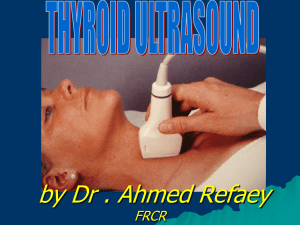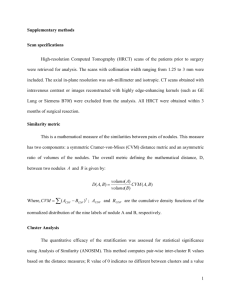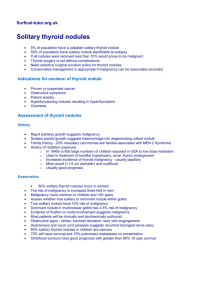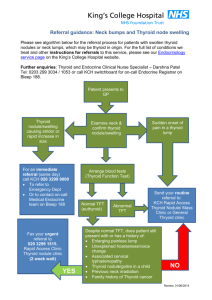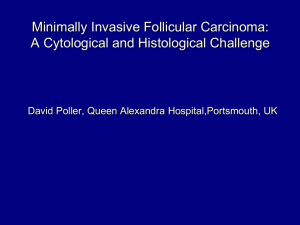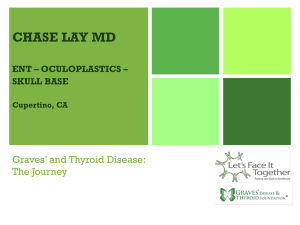Ashraf Talaat Mahmoud Abd El Samad_Life Science Journal 2012
advertisement
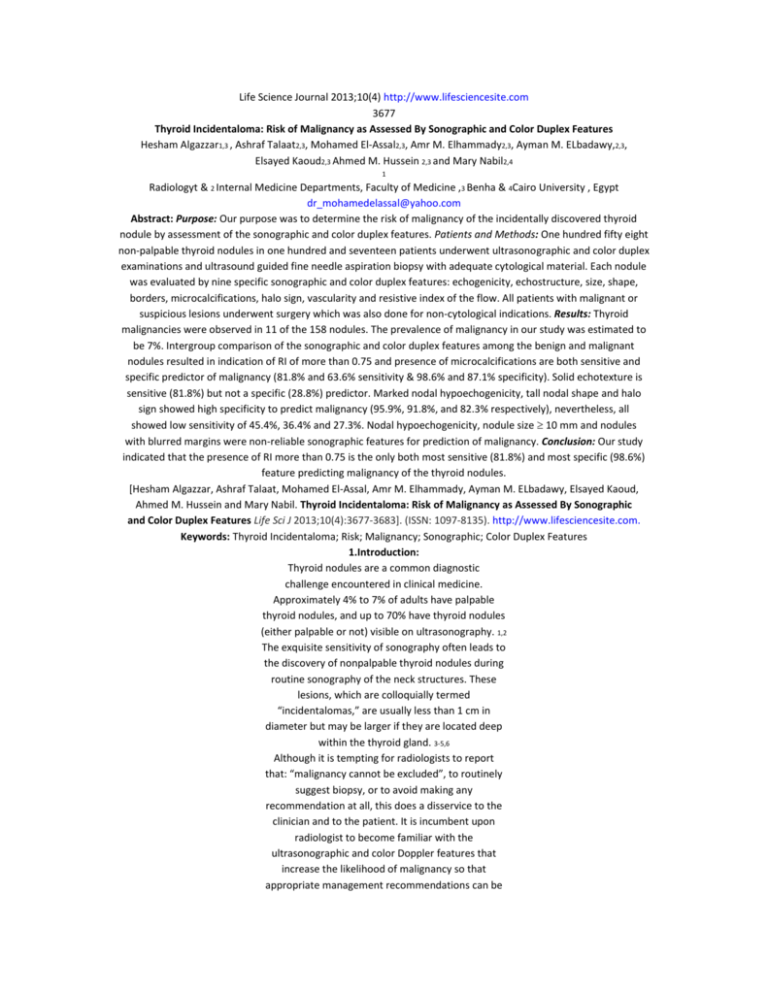
Life Science Journal 2013;10(4) http://www.lifesciencesite.com 3677 Thyroid Incidentaloma: Risk of Malignancy as Assessed By Sonographic and Color Duplex Features Hesham Algazzar1,3 , Ashraf Talaat2,3, Mohamed El-Assal2,3, Amr M. Elhammady2,3, Ayman M. ELbadawy,2,3, Elsayed Kaoud2,3 Ahmed M. Hussein 2,3 and Mary Nabil2,4 1 Radiologyt & 2 Internal Medicine Departments, Faculty of Medicine ,3 Benha & 4Cairo University , Egypt dr_mohamedelassal@yahoo.com Abstract: Purpose: Our purpose was to determine the risk of malignancy of the incidentally discovered thyroid nodule by assessment of the sonographic and color duplex features. Patients and Methods: One hundred fifty eight non-palpable thyroid nodules in one hundred and seventeen patients underwent ultrasonographic and color duplex examinations and ultrasound guided fine needle aspiration biopsy with adequate cytological material. Each nodule was evaluated by nine specific sonographic and color duplex features: echogenicity, echostructure, size, shape, borders, microcalcifications, halo sign, vascularity and resistive index of the flow. All patients with malignant or suspicious lesions underwent surgery which was also done for non-cytological indications. Results: Thyroid malignancies were observed in 11 of the 158 nodules. The prevalence of malignancy in our study was estimated to be 7%. Intergroup comparison of the sonographic and color duplex features among the benign and malignant nodules resulted in indication of RI of more than 0.75 and presence of microcalcifications are both sensitive and specific predictor of malignancy (81.8% and 63.6% sensitivity & 98.6% and 87.1% specificity). Solid echotexture is sensitive (81.8%) but not a specific (28.8%) predictor. Marked nodal hypoechogenicity, tall nodal shape and halo sign showed high specificity to predict malignancy (95.9%, 91.8%, and 82.3% respectively), nevertheless, all showed low sensitivity of 45.4%, 36.4% and 27.3%. Nodal hypoechogenicity, nodule size 10 mm and nodules with blurred margins were non-reliable sonographic features for prediction of malignancy. Conclusion: Our study indicated that the presence of RI more than 0.75 is the only both most sensitive (81.8%) and most specific (98.6%) feature predicting malignancy of the thyroid nodules. [Hesham Algazzar, Ashraf Talaat, Mohamed El-Assal, Amr M. Elhammady, Ayman M. ELbadawy, Elsayed Kaoud, Ahmed M. Hussein and Mary Nabil. Thyroid Incidentaloma: Risk of Malignancy as Assessed By Sonographic and Color Duplex Features Life Sci J 2013;10(4):3677-3683]. (ISSN: 1097-8135). http://www.lifesciencesite.com. Keywords: Thyroid Incidentaloma; Risk; Malignancy; Sonographic; Color Duplex Features 1.Introduction: Thyroid nodules are a common diagnostic challenge encountered in clinical medicine. Approximately 4% to 7% of adults have palpable thyroid nodules, and up to 70% have thyroid nodules (either palpable or not) visible on ultrasonography. 1,2 The exquisite sensitivity of sonography often leads to the discovery of nonpalpable thyroid nodules during routine sonography of the neck structures. These lesions, which are colloquially termed “incidentalomas,” are usually less than 1 cm in diameter but may be larger if they are located deep within the thyroid gland. 3-5,6 Although it is tempting for radiologists to report that: “malignancy cannot be excluded”, to routinely suggest biopsy, or to avoid making any recommendation at all, this does a disservice to the clinician and to the patient. It is incumbent upon radiologist to become familiar with the ultrasonographic and color Doppler features that increase the likelihood of malignancy so that appropriate management recommendations can be made.3 Some studies considered that fine needle aspiration biopsy (FNAB) is the standard diagnostic test for evaluating a palpable thyroid nodule in euthyroid patients,6,7 but the evaluation of the nonpalpable thyroid nodule is still controversy. 8,9 Although no single feature is 100% predictive, several sonographic features are known to increase the likelihood of thyroid malignancy. Many studies have sought to identify sonographic features that are both sensitive and specific for malignant versus benign disease.10-13 Objectives: The aim of our study was to determine the risk of malignancy of the incidentally discovered thyroid nodule by assessment of the sonographic and color duplex features. 2.Patients and methods: During a period of 24 months, 158 nodule were detected in 117 patients participated in the study. All nodules were incidentally discovered by ultrasound performed for the following indications: ultrasonography of the neck for swallowing difficulties, hoarseness or neck discomfort, examination of palpable thyroid nodule, homogenous goiter and hypo- or hyper-thyroidism either approved or clinically suspected. Life Science Journal 2013;10(4) http://www.lifesciencesite.com 3678 All patients underwent ultrasound examination and US-FNAB. Cases were selected from 172 patients, having 241 nodules. Entry criteria included presence of thyroid nodule that was discovered incidentally at ultrasound evaluation and was nonpalpable at physical examination; greatest diameter of the lesion was more than 5 mm; and nodules with sufficient cytological material during ultrasound guided fine needle aspiration biopsy (US-FNAB). Patients were 75 females (mean age, 32.2 years; range, 12–65 years) and 42 males (mean age, 34.9 years; range, 15-72 years). Ultrasound and color duplex sonography were performed using Philips (ATL HDI 5000 sonoCT) with 5-12 MHz linear probe. Ultrasound examination of the nodules was interpreted with respect to nine ultrasound and color duplex features. These were echogenicity, echostructure, size, shape, borders, microcalcifications, halo sign, vascularity and resistive index of the flow. Echogenicity categories included; markedly hypoechoic to adjacent strap of muscles and hypoechoic, isoechoic or hyperechoic to the thyroid gland. Echo structure categories included; solid, mixed or cystic nodules. Nodal size categories included either < 10 mm or 10 mm. Shape categories included tall or not tall (rounded and broad). Border categories included well-defined or blurred borders, microcalcifications (which is the presence of less than 2 mm intranodal calcifications) categories included present or absent, halo sign categories included present or absent, vascularity categories included absent flow, central or peripheral flow, mixed vascularity was categorized central. Resistive index of the flow categories included 0.75 or > 0.75. For US-FNAB, informed consent was obtained from the patient. While the patient was lying supine, the nodule to sample was localized by ultrasonography, under aseptic conditions, the skin and subcutaneous tissues in the projected needle path were anesthetized using 1% lidocaine (Xylocaine, Astra, Westborough, MA). A 23-gauge needle coupled with a 10-mL syringe is then placed into the nodule using continuous free-hand sonographic guidance. Specimens were obtained first by non aspiration sampling technique. If the biopsy passes do not yield cellular specimen we switched to suction aspiration technique. After a biopsy pass, the needle was withdrawn from the neck and the sample was smeared onto glass slides. Five or more passes were made through the nodule. Cytological specimens were evaluated by an experienced cytopathologist and classified as benign, suspicious or malignant. Patients with benign cytology were advised to undergo follow up by clinical and ultrasound examinations after 6 months to rule out changes in nodule volume or clinical features. The follow up results were not included in the study. The final diagnosis of benign or malignant was done by FNAB and surgery. Indications for surgery were FNAB diagnosis of malignant or suspicious lesions, relatively large (supracentimetric) nodule or isolated cold nodule, simultaneous presence of incidentaloma in diffuse goiter with compression symptoms, hyperthyroidism, and cervical adenopathy. The US and color duplex features of the finally diagnosed benign and malignant nodules were compared in order to define the features of the malignant and benign nodules. 3.Results: One hundred fifty eight nodules were discovered in 117 patients included in our study. Of these 147 nodules were benign nodules and 11 were malignant nodules. We calculated the sensitivity, specificity, positive predictive value (PPV), negative predictive value (NPV) and accuracy for each sonographic feature. The comparative intergroup analysis of the sonographic and duplex Doppler features found among the benign and malignant nodules in this study shown in Table 1. Malignant nodules presented more frequently than did benign nodules as tall 36.4% vs. 8.2%, markedly hypoechoic (45.5% vs. 4.1%), with microcalcifications (63.6% vs. 12.9%) and showed resistive index more than 0.75 in 81.8% vs. 1.4% (Figs 1 -4). None of the 11 malignant nodules or the 147 benign nodules was entirely cystic, 9 of the malignant nodules (81.8%) were homogonously solid and 2 were mixed. On the other hand, 105 of the benign nodules were homogenously solid and 42 were mixed (Figs 5-9). Solid echotexture and microcalcifications were the most sensitive independent sonographic features predicting malignancy (81.8% and 63.6% respectively). However, because the solid echotexture is one of the common features in both malignant and benign nodules (81.8% vs. 71.4%), it showed low specificity 28.6%, compared to high specificity (87.1%) of the microcalcifications in prediction of malignancy (Table 2). In addition to the microcalcifications as a specific sonographic feature in detection of malignancy, there were three more other features; marked nodal hypoechogenicity, tall nodal shape and halo sign, which were also the most independent specific features to predict malignancy (95.9%, 91.8%, and 82.3% respectively), nevertheless, all showed low sensitivity of 45.5%, 36.4% and 27.3% respectively in detection of malignancy (Table 2).Nodal hypoechogenicity, nodule size 10 mm and Life Science Journal 2013;10(4) http://www.lifesciencesite.com 3679 nodules with blurred margins were non-reliable sonographic features for prediction of malignancy as they were both low sensitive and low specific as well as they yield markedly low PPV for detection of malignancy. Central vascularity was seen in 6 (54.5%) out of the 11 malignant nodules, and 71 (48.3%) out of the 147 benign nodules. Peripheral vascularity was seen in 45.5% of the malignant nodules and 49.7% of the benign nodules (Figs 1011). Three nodules showed absent vascularity and all were benign. Central vascularity was another nonreliable feature for prediction of malignancy, as it showed low sensitivity of 54.5%, low specificity of 51.7 % and a very low PPV of 7.8% (Table 2). Analysis of the RI of the thyroid nodules showed that RI of more than 0.75 was both the most sensitive and the most specific feature (81.8% and 98.6%) in prediction of malignancy of the nonpalpable thyroid nodules (Figs 4 and 12). Moreover, it also the single most feature showed high PPV (81.8%), high NPV (98.6%) and high accuracy (97.4%). Table1. Comparative intergroup analysis of the sonographic and color Doppler features found among the benign and malignant nodules Benign Malignant No of nodules (%) No of nodules (%) Echogenicity Markedly hypoechoic 6 (4.1%) 5 (45.5%) Hypoechoic 63 (42.9%) 4 (36.4%) Isoechoic 64 (43.5%) 1 (9.1 %) Hyperechoic 14 (9.5%) 1 (9.1%) Echostructure Solid 105 (71.4%) 9 (81.8%) Predominantly solid 42 (28.6%) 2 (18.2%) Size < 10 mm 83 (56.5%) 6 (54.5%) ≥ 10 mm 64 (43.5%) 5 (45.5%) Shape Tall 12 (8.2%) 4 (36.4%) Broad or rounded 135 (91.8%) 7 (63.6%) Borders Well-defined 73 (49.7%) 5 (45.5%) Blurred 74 (50.3%) 6 (54.5%) Microcalcifications Present 19 (12.9%) 7 (63.6%) Absent 128 (87.1 %) 4 (36.4%) Halo sign Present 26 (17.7%) 3 (27.3%) Absent 121 (82.3%) 8 (72.7%) Vascularity Absent 3 (2%) 0 (0%) Central 71 (48.3%) 6 (54.5%) Peripheral 73 (49.7%) 5 (45.5%) Resistive index ≤ 0.75 142 (98.6%) 2 (18.2%) > 0.75 2 (1.4%) 9 (81.8%) Table2. Ultrasonographic and Doppler specific features for malignancy Number Sensitivity Specificity PPV NPV Accuracy Solid echotexture 9 81.8% 28.6% 7.9% 95.5% 32.3% Microcalcifications 7 63.6% 87.1% 26.9% 97% 85.4% Marked hypoechogenicity 5 45.5% 95.9% 45.5% 95.9% 99.3% Tall shape 4 36.4% 91.8% 25% 95.1% 8.8% Halo sign 3 27.3% 82.3% 10.3% 93.8% 78.5% Central vascularity 6 54.5% 51.7% 7.8% 93.8% 52% RI > 0.75 9 81.8% 98.6% 81.8% 98.6% 97.4% Life Science Journal 2013;10(4) http://www.lifesciencesite.com 3680 Fig 1: Transverse sonogram showing malignant tall nodule with blurred margins Fig 2: Longitudinal sonogram showing benign hypoechoic thyroid nodule with hallo sign and microcalcifications (arrowed). Two small satellite lesions are noted. Fig 3: Transverse sonogram of the left thyroid lobe showing isoechoic malignant nodule with microcalcifications Fig. 4: Color duplex examination of malignant nodule showing central vascularity, RI = 0.77 Fig. 5: Longitudinal sonogram of the left thyroid lobe showing benign mixed thyroid nodule with halo sign. Fig. 6: Transverse sonogram of the right thyroid lobe showing benign oval hypoechoic nodule with blurred margins Fig. 7: Transverse scan of the right thyroid lobe showing benign hyperechoic nodule with blurred margins. Fig 8: Transverse sonogram of the right thyroid lobe showing benign isoechoic rounded nodule with marginal microcalcifications. Life Science Journal 2013;10(4) http://www.lifesciencesite.com 3681 Fig. 9: Transverse sonogram of the right thyroid lobe showing two adjacent benign nodules, solid isoechoic nodule (A) and mixed hypoechoic nodule (B), two spots of microcalcifications were noted (arrowed). Fig. 10: Longitudinal san of the right thyroid lobe showing broad benign hypodense lesion with peripheral vascularity. Fig. 11: Transverse sonogram of the left thyroid lobe showing benign hypoechoic solid lesion with peripheral vascularity. Fig. 12: Longitudinal sonogram of the left thyroid lobe showing benign mixed thyroid nodule with central and peripheral vascularity, RI = 0.69. 4.Discussion: The non-palpable thyroid nodules occur relatively frequently and the use of new radiological imaging techniques has made the detection of large number of thyroid incidentalomas possible in the general population.9,14 Thyroid incidentalomas were identified in 13: 17% during scanning of the neck for non thyroid indications. 15-17Many reports have discussed sonographic findings of the thyroid mass, however, a considerable overlap of characteristics in benign and malignant lesions was found, and the optimal method of managing non-palpable thyroid nodule is a matter of controversy. 10,18-19 Many institutions have adopted the practice of performing biopsy on all nodules that appear larger than 1.0 cm in diameter without regard to sonographic appearance. However, some studies have reported cases of metastatic spread of occult papillary carcinoma of the thyroid as small as 2 mm in diameter. Thus, the finding of relatively sensitive and highly specific sonographic features that would make a nonpalpable thyroid nodule suggestive of malignancy and worthy of sonographically guided FNA biopsy would have important implications in the treatment of thyroid incidentalomas. 5,20-23 The prevalence of cancer in our study was 7%. It was lower than reported by Papini et al9 (7.7%), and higher than reported by Leenhardt et al6 (5.4%). Several studies have mentioned hypoechogenicity as finding suggestive of malignancy, however, most nonpalpable thyroid nodules are hypoechoic, and most of these are benign. In our study hypoechoic nodules in respect to the thyroid gland was a common sonographic feature in both benign and malignant nodules in this study (42.9% vs. 36.4%). Kim et al4 attempted to differentiate markedly hypoechoic lesions in respect to the adjacent strap of muscle, and only markedly hypoechoic lesions were considered a finding indicative of malignancy and reported sensitivity of 26.5%, specificity of 94.3%, PPV of 68.4% and NPV of 73.5%. In our study, markedly hypoechoic nodule was sensitive to detect 5 (45.5%) of the 11 malignant nodules with 95.9% specificity, 45.5% PPV and 95.9% NPV. On the other hand, the isoechoic feature was more common in benign nodules than in malignant nodules (43.5% vs. 9.1%) and the hyperechoic nodule was relatively rare within both groups, constituting only 9.5% of benign and 9.1% of malignant nodules. Our study indicated that a solid echotexture was one of the most sensitive criteria to predict malignancy (81.8%), however, it was also the most common feature among benign nodules in this study 71.4%. Microcalcification is a common finding in patients with palpable thyroid papillary carcinoma. It Life Science Journal 2013;10(4) http://www.lifesciencesite.com 3682 is not often seen in nonpalpable thyroid nodule. 4 Microcalcifications were seen in 19 (12.9%) of 147 benign nodules and 7 (36.6%) of the 11 malignant nodules in this study. The presence of microcalcifications was determined to be 87.1% specific for malignancy (PPV of 26.9%, NPV of 97% and accuracy of 85.4%). Similarly we applied a nodule shape more tall than wide and positive halo sign as findings suggestive of malignancy and they showed that, they were not a sensitive (36.4% and 27.3% respectively) but a very specific finding (91.8% and 82.3% respectively), and thus microcalcifications, tall nodule and positive halo sign could be used as an ancillary findings of nonpalpable thyroid malignancies. Unlike prior investigators, we did not find a high association of blurred margins in malignant thyroid nodules. Only 54.5% of malignant nodules in our study had blurred margins with specificity of 49.7 % and PPV of 7.5% for malignancy, compared with Papini et al., 9 series which found a sensitivity of 77.5%, specificity of 85% and PPV of 30%. In accordance with the previous reports,9,10 size is not a reliable indicator of begin or malignant nature of the nodule and a dimensional cut-off of 10 mm nodule diameter seemed unhelpful, in our study, 54.5% of the malignant nodules were less than 10 mm in comparison to 56.5% of the benign nodules and 45.5 % of the malignant nodules were equal or more than 10 mm in comparison to 43.5 % of the benign nodules. Nodule size more than 10 mm showed specificity of 56.5 %, PPV of 7.2% and NPV of 93.3%. It is important to note that; the parameters of the flow pattern depends on the Doppler sitting, the equipment and on the radiologist. 20 In our study we made the necessary adjustments to pulse repetition frequency, wall filter, and sample volume size to optimize flow imaging and to minimize artifacts, (pulse repetition frequency 1250Hz, wall filter medium, color gain 15-20). De Nicola20 reported that the malignant nodules predominantly had central vascularization, whereas the benign nodules predominantly had peripheral vascularization. On the other hand, Frates et al2 explored the value of color Doppler flow patterns in predicting malignancy, they found that there was significant overlap in color flow patterns, and benign and malignant nodules could not be reliably distinguished. In our study, absent flow was seen only in 3 nodules which were all benign. Absent flow was determined to be 100% specific and 100% PPV for benignity, however, it showed low sensitivity 2%. Benign nodules showed central and peripheral types of vascular flow in 48.3% and 49.7 % compared with malignant nodules which showed 54.5% and 45.5% respectively. Central type of vascular flow showed low specificity (51.7%) and very low PPV (7.8%) and high NPV (93.8%). Few studies analyzing the RI of the thyroid nodules were found in the literature and had reported results similar to our study results. Cerbone et al., 24 found an RI more than 0.75 showed sensitivity of 85.7%. Holden25 and De Nicola et al., 20 found a mean RI values of 0.75 in carcinoma. Bianek-Bodzak et al26 reported that RI more than 0.75 is a good predictive of malignancy of the thyroid nodule with a sensitivity of 73.3%, a specificity of 98.1% and positive predictive value of 91.6%. In our study RI of more than 0.75 showed sensitivity of 81.8%, a specificity of 98.6%, PPV of 81.8% and NPP of 98.6%. In our study the most sensitive and most specific predictor for malignancy was the RI more than 0.75. A management strategy that included biopsy of all nodules having RI more than 0.75 would have resulted in detection of 81.8% of the cancers and would have required biopsy of 11 (7.2%) out of 158 nodules. Implementing the strategy of RI more than 0.75 as an indication for US-FNAB of the non-palpable thyroid nodules will immediately reduce the number of FNABs, but it will not reduce the number of thyroid ultrasounds needed to monitor changes in the non-biopsyed nodules. Additional studies are needed to assess optimal follow-up of the non- biopsyed nodules, as well as for nodules that are too small for biopsy. Equally important, studies are needed to establish the appropriate role of thyroid ultrasound as a screening tool in clinical practice. Conclusion: In conclusion, many ultrasonographic features used to predict malignancy, yet no feature was 100% sensitive and specific. Only RI more than 0.75 was both the most sensitive and the most specific feature to predict malignancy. In addition, solid pattern and microcalcifications were sensitive features and marked hypoechogenicity, tall shape, microcalcifications and halo sign were specific features predictive of malignancy. Nodal size, hypoechogenicity, blurred margins and central pattern of vascular flow are non-reliable features to predict malignancy. References: 1. Marqusee E, Benson C, Frates M, et al. Usefulness of ultrasonography in the management of nodular thyroid disease. Ann Intern Med 2000; 133: 696– 700. 2. Frates MC, Benson CB, Doubilet PM, Cibas ES, Marqusee E. Can color Doppler sonography aid in Life Science Journal 2013;10(4) http://www.lifesciencesite.com 3683 the prediction of malignancy of thyroid nodules? J Ultrasound Med 2003; 22:127–131. 3. Tessler FN and Tublin ME. Thyroid Sonography: Current Applications and Future Directions. AJR 1999;173: 437-443. 4. Kim EK, Cheong SP, Woung YC, et al. New sonographic criteria for recommending fine-needle aspiration biopsy of nonpalpable solid nodules of the thyroid. AJR 2002; 178:687–691. 5. Iannuccilli JD, Cronan JJ, Monchik JM. Risk for Malignancy of Thyroid Nodules as Assessed by Sonographic Criteria The Need for Biopsy. J Ultrasound Med 2004; 23:1455–1464. 6. Leenhardt l, Hejblum G, Franc B, Fediaevsky L, Delbot T, Le Guillouzic D, Ménégaux F, Hoang CG, Turpin G and Aurengo A. Indications and limits of ultrasound-guided cytology in the management of nonpalpable thyroid nodules. J Clin Endocrinol Metab 1999; 84: 24-28 7. Gharib H. Fine-needle aspiration biopsy of thyroid nodules: advantages, limitations, and effect. Mayo Clin Proc 1994; 69: 44–49. 8. Nam-Goong IS, Kim HY, Gong G, et al. Ultrasonography-guided fine-needle aspiration of thyroid incidentaloma: correlation with pathologic findings. Clin Endocrinol (Oxf) 2004; 60: 21 –28. 9. Papini E, Guglielmi R, Bianchini A, Crescenzi A, Taccogna S, Nardi F, Panunzi C, Rinaldi R, Toscano V and Claudio M. Risk of malignancy in nonpalpable thyroid nodules: predictive value of ultrasound and color-Doppler features. J Clin Endocrinol Metab 2002; 87: 1941 -1946. 10. Titton RL, Gervais DA, Boland GW, Maher MM, Mueller PR. Sonography and Sonographically Guided Fine-Needle Aspiration Biopsy of the Thyroid Gland: Indications and Techniques, Pearls and Pitfalls. AJR 2003; 181: 267–271. 11. Ross DS. Editorial: nonpalpable thyroid nodules: managing an epidemic. J Clin Endocrinol Metab 2002; 87: 1938–1940. 12. Rago T, Vitti P, Chiovato L, et al. Role of conventional ultrasonography and color flowDoppler sonography in predicting malignancy in “cold” thyroid nodules. Eur J Endocrinol 1998; 138: 41 –46. 13. Chan BK, Desser TS, McDougall IR, Weigel RJ, Jeffrey RP. Common and Uncommon Sonographic Features of Papillary Thyroid Carcinoma. J Ultrasound Med 2003;22:1083–1090. 14. Liebeskind A, Sikora AG, Komisar A, Slavit D, Fried K. Rates of malignancy in incidentally discovered thyroid nodules evaluated with sonography and fine-needle aspiration. J Ultrasound Med 2005; 24: 629–634. 15. Yousem DM, Huang T, Loevner LA, Langlotz CP. Clinical and economic impact of incidental thyroid lesions found with CT and MR. AJNR 1997; 18: 1423–1428. 16. Horlocker TT, Hay JE, James EM, Reading CC, Charboneau JW. Prevalence of incidental nodular thyroid disease detected during high-resolution parathyroid ultrasonography. In: Medeiros-Neto G, Gaitan E (eds). Frontiers in Thyroidology: Vol 2, NY, Plenum Medical 1985; 1309–1312. 17. Carroll BA. Asymptomatic thyroid nodules: incidental sonographic detection. AJR 1982; 138: 499–501. 18. Kumar H, Daykin J, Holder R, Watkinson JC, Sheppard MC, Franklyn JA. Gender, clinical findings, and serum thyrotropin measurements in the prediction of thyroid neoplasia in 1005 patients presenting with thyroid enlargement and investigated by fine-needle aspiration cytology. Thyroid 1999; 9: 1105–1109. 19. Tollin SR, Mery GM, Jelveh N, et al. The use of fine-needle aspiration biopsy under ultrasound guidance to assess the risk of malignancy in patients with a multinodular goiter. Thyroid 2000; 10: 235– 241. 20. De Nicola H, Szejnfeld J, Logullo AF, Wolosker AM, Souza LR, Chiferi V. Flow Pattern and Vascular Resistive Index as Predictors of Malignancy Risk in Thyroid Follicular Neoplasms. J Ultrasound Med 2005; 24: 897–904. 21. Wang C, Crapo LM. The epidemiology of thyroid disease and the implications for screening. Endocrinol Metab Clin North Am 1997; 26: 189– 218. 22. Yamamoto Y, Maeda T, Izumi K, Otsuka H. Occult papillary carcinoma of the thyroid: a study of 408 autopsy cases. Cancer 1990; 65: 1173–1179. 23. Neuhold N, Kaiser H, Kaserer K. Latent carcinoma of the thyroid in Austria: a systemic autopsy study. Endocr Pathol 2001; 12: 23–31. 24. Cerbone G, Spiezia S, Colao A, et al. Power Doppler improves the diagnostic accuracy of color Doppler ultrasonography in cold thyroid nodules: follow-up results. Horm Res 1999; 52: 19–24. 25. Holden A. The role of colour and duplex Doppler ultrasound in the assessment of thyroid nodules. Australasian Radiology 1995; 39: 343–349. 26. Bianek-Bodzak A, Zaleski K, Studniarek M, Mechlinska-Baczkowska J. Color Doppler Sonography in Malignancy of Thyroid Nodules. J Ultrasound Med 2003; 22: 753–758. 12/11/2013
